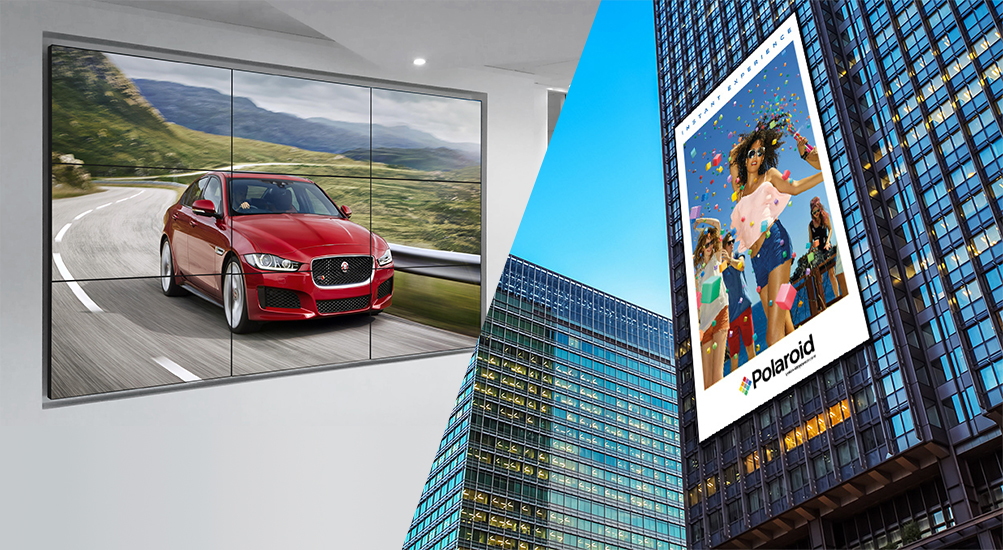
Video Walls – LCD vs. LED
Introduction
In this blog post, I will outline the difference between LED-backlit LCD displays and LED-only displays before discussing the strengths and weaknesses of our LCD and LED Video Wall solutions.
What is LCD?
LCD, which stands for Liquid Crystal Display, is a type of panel display that is used in televisions, computer monitors, smartphones and many of our Digital Signage products.
Changes in Terminology
Until around ten years ago, LCD panels were most commonly illuminated by CCFL (Cold Cathode Fluorescent Lamp) backlights. However, due to advantages like being more energy efficient, slimmer and longer lasting, LED (Light Emitting Diode) backlights have become the industry standard – both for domestic and commercial displays.
As a result, to promote the fact that they were using LED backlights, many domestic TV manufacturers began labelling displays that still contained an LCD panel as ‘LED displays’. This created confusion when distinguishing between these LED-backlit LCD displays (hereafter ‘LCD displays’) and LED-only displays (hereafter ‘LED displays’), which do not contain an LCD panel at all.
At Allsee, we manufacture both LCD Video Walls and LED Video Walls. This means that understanding the difference between these two types of display is vital for our customers to be able to make a well-informed choice when deciding what type of Digital Signage is right for their project.
Therefore, for the remainder of this blog post, I will focus on outlining the pros and cons of each type of Video Wall.
LCD Video Walls vs. LED Video Walls

One of the main differences between LCD and LED displays is the way the pixels are lit. As mentioned above, LCD displays comprise an LCD panel with an LED backlight to illuminate the pixels. Comparatively, LED displays use independently illuminated pixels, meaning that each pixel is effectively its own backlight.
This means that in LCD Video Walls, black is created by blocking out the backlight behind certain pixels. As it is impossible to fully block the backlight, LCD displays are unable to produce true black. This is one of the strengths of LED Video Walls: as each pixel can fully turn off its backlight, it is possible to produce ultra-high contrast ratios. Additionally, as each pixel can be controlled independently, LED displays can produce more natural colours than LCD displays.
Another weakness of LCD Video Walls is that the content displayed will be broken up by a bezel. Although the bezel size on our LCD Video Wall is super slim at just 3.5mm screen-to-screen, LED Video Walls are completely bezel-less and so allow seamless content.
However, LCD Video Walls have the potential to display in 4K resolution, whereas the resolution of an LED Video Wall is dependent on its pixel pitch. Even at the smallest pixel pitches, if you were to view an LED Video Wall from very close-up, you would be able to see individual pixels.

When it comes to installation, both types of display have their strengths and weaknesses. On one hand, the LCD panels in LCD Video Walls are more fragile and so are more likely to be damaged, whereas LED Video Walls have more robust enclosures. On the other hand, LCD Video Walls are more common so installers are more likely to be experienced at fitting them, whereas LED Video Walls require bespoke installation.
Compared to LED Video Walls, LCD Video Walls are a much more affordable solution, allowing you to create a striking large-scale display on a smaller budget. Conversely, LED Video Walls are a cutting-edge technology but as a result are more expensive, making them ideal as a premium solution for projects with a higher budget.
Summary
I hope this blog post has cleared up some of the confusion surrounding LED-backlit LCD displays and LED-only displays, especially when choosing between our LCD and LED Video Wall solutions.
Both have different strengths and weaknesses, meaning the suitability of each depends on the specific requirements of your project. LCD is the more prevalent, more affordable option; LED is the new kid on the block, with a range of benefits but a more expensive price tag to match.
If you would like to discuss which option would be right for you, get in touch today and we will be happy to help!

Chloe Weaver is the Digital Marketing Executive at Allsee Technologies.


